Monday.com Integration with ShipChain
Automate your logistics workflow and enhance shipment tracking by connecting ShipChain with Monday.com CRM.
Overview of Monday.com and Shipchain
ShipChain and Monday.com are powerful tools that, when integrated, offer a seamless solution for businesses to streamline their logistics and project management processes. ShipChain, a robust logistics platform, provides real-time shipment tracking.On the other hand, Monday.com is a versatile work operating system that empowers teams to plan, track, and manage projects.
Monday.com
What it is: A cloud-based Work OS for project management, team collaboration, and workflow automation.
Key Features:
-
- Customizable boards for task tracking.
- Automation of repetitive tasks.
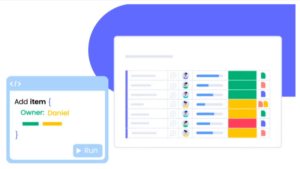
- Integration with 200+ apps via APIs, webhooks, and third-party tools like Zapier.
- Real-time collaboration and reporting.
API: monday.com provides a GraphQL API for custom integrations, allowing CRUD operations on boards, items, and columns.
Shipchain
What it is: A logistics and SCM platform that uses blockchain technology (Ethereum-based) to enhance transparency, security, and efficiency in supply chains.
Key Features:
- Real-time tracking of goods across the supply chain.
- Inventory optimization with predictive analytics.

- Compliance with global trade regulations.
- Secure data management with blockchain-based smart contracts and Data Vaults.
- RESTful web services for integration with external systems.
API: Shipchain offers APIs for interacting with its blockchain-based ecosystem, including shipment tracking, smart contract execution, and data vault management.
What is ShipChain?
ShipChain is a comprehensive logistics platform designed to automate, monitor, and manage your shipments from start to finish. It enables businesses to track their deliveries in real-time, optimize their supply chains, and improve operational efficiency.

-
Real-time tracking
-
Supply chain optimization
-
Automated workflows
-
Performance analytics
What is Monday.com?
Monday.com is a work operating system that allows teams to build custom workflows for any process. It provides tools for task management, project tracking, and team collaboration, all through a simple, intuitive interface.

-
Custom workflows
-
Task management
-
Team collaboration
-
Process automation
Why Integrate monday.com with Shipchain?
Integrating monday.com with Shipchain can bridge project management with supply chain operations, offering benefits such as:
- Centralized Workflow: Manage tasks in monday.com while tracking shipments and inventory in Shipchain.
- Real-Time Updates: Sync shipment status updates from Shipchain to monday.com boards for team visibility.
- Automation: Automate task creation or updates in monday.com based on supply chain events (e.g., shipment delays or inventory shortages).

- Enhanced Decision-Making: Combine Shipchain’s analytics with monday.com’s reporting for better operational insights.
- Compliance and Security: Leverage Shipchain’s blockchain for secure, auditable data and monday.com’s access controls for team collaboration.
Prerequisites
Before starting, ensure you have:
monday.com Account:
-
-
- Admin access to create API tokens and configure integrations.
- Familiarity with boards, items, and automations.
-
Shipchain Account:
-
-
- Access to Shipchain’s platform with API credentials.
- Understanding of Shipchain’s shipment tracking, inventory, or compliance features.
-
Technical Requirements:
-
-
- Basic knowledge of APIs, JSON, and REST/GraphQL.
- (Optional) Access to third-party tools like Zapier, Make.com, or n8n.
-
API Documentation:
-
-
- monday.com API: developers.monday.com
- Shipchain API: Refer to docs.shipchain.io or contact Shipchain support for detailed API specs.
-
Security Setup:
-
- Secure storage for API tokens.
- Compliance with GDPR, CCPA, or other relevant regulations.
Integration Options
Since no native integration exists, you can use one of the following approaches:
Step 1: Secure Your API Keys
You’ll need to generate API keys from both ShipChain and Monday.com to authenticate your requests.
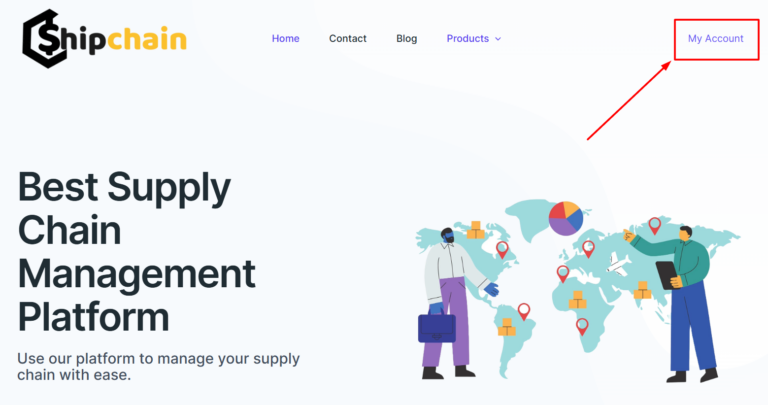
Step 2: Authenticate Your APIs
Use the API keys from the previous step to authenticate your requests with both ShipChain and Monday.com APIs.
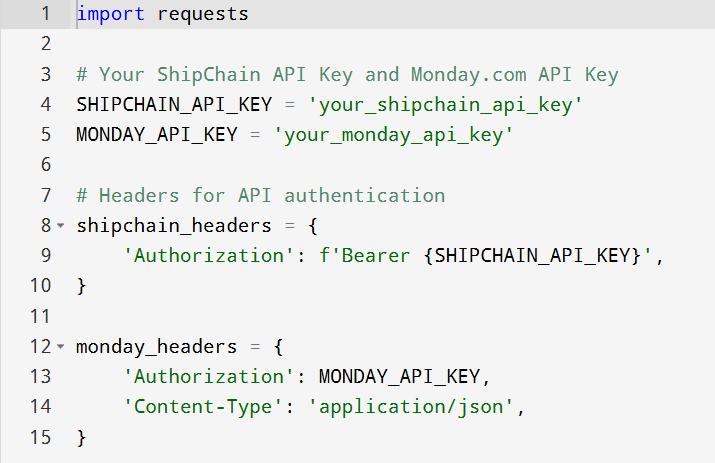
Step 3: Pull Shipment Data from ShipChain
Use the ShipChain API to make a GET request and retrieve shipment data. Handle the API response and extract the required data (e.g., shipment name, status).
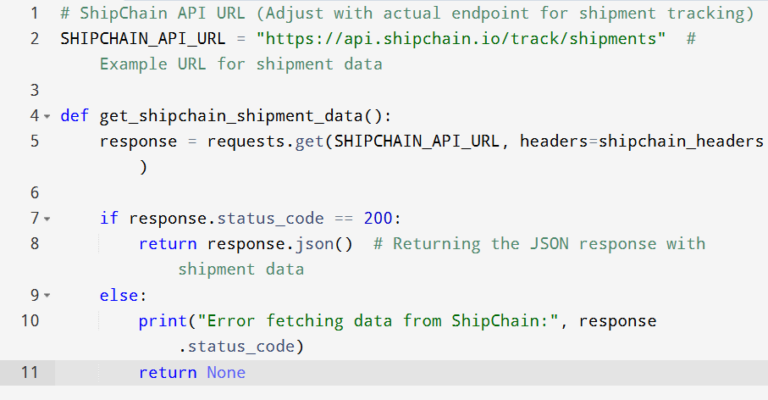
Step 4: Create Tasks in Monday.com
Use Monday.com API to create a task (item) for the shipment in the appropriate Monday.com board, mapping the data you fetched from ShipChain.
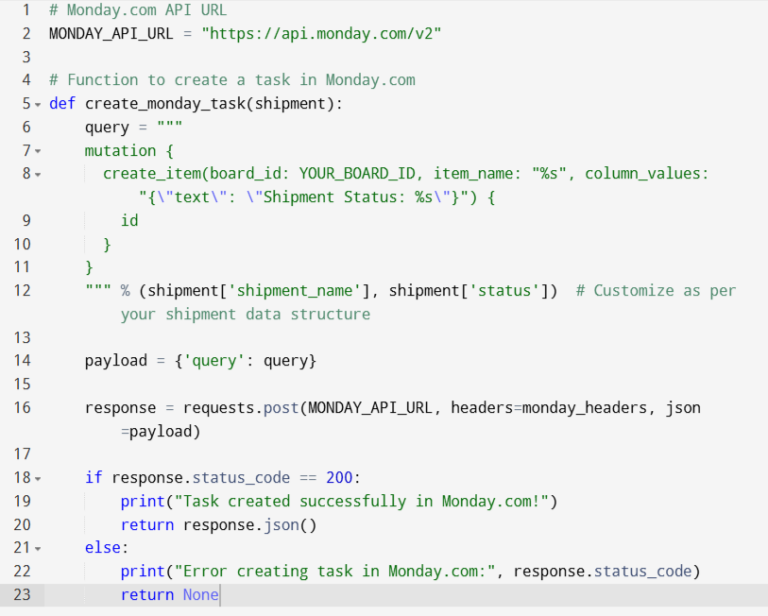
Step 5: Supercharge with Automation (Optional)
Optionally, set up automated workflows to trigger task creation and updates in Monday.com whenever a new shipment is created or its status changes.

Step 6: Test Your Integration
Test the integration by creating sample shipments in ShipChain and verifying that tasks are created/updated as expected in Monday.com.

Step 7: Handle Errors Like a Pro
Include steps for troubleshooting issues that might arise during integration, such as syncing issues or API errors.

Final Step: Deploy and Monitor
Once the integration is working correctly, deploy it using cron jobs or task schedulers to automate the process. You should also monitor the integration regularly to ensure everything continues working as expected.
Security Considerations
Data Encryption: Ensure API calls use HTTPS and data is encrypted in transit.
Authentication: Use API tokens securely and implement two-factor authentication where possible.
Access Control: Restrict API access to authorized users and roles in both platforms.
Compliance: Verify that the integration complies with GDPR, CCPA, or other regulations, especially for sensitive supply chain data.
Shipchain’s Blockchain: Leverage Shipchain’s blockchain for immutable, auditable data to enhance security.
Audit Logs: Monitor API usage and maintain logs for troubleshooting and compliance.
Conclusion
Integrating Monday.com with Shipchain enables businesses to combine robust project management with advanced supply chain capabilities. While no native integration exists, custom API integrations, third-party tools like Zapier, or platforms like n8n offer flexible solutions. By following this guide, you can automate workflows, enhance visibility, and drive operational efficiency.
For the latest integration options, check with Monday.com’s app marketplace or Shipchain’s support team. If you need assistance, consider hiring a developer or consulting integration specialists.
FAQs: ShipChain and Monday.com Integration
How does the ShipChain and Monday.com integration work?
The integration allows you to connect ShipChain‘s real-time shipment data with Monday.com. It automatically creates tasks or updates existing tasks in Monday.com based on shipment status changes, providing seamless automation of your logistics workflow. You can track shipments, update statuses, and automate task management—all within your CRM system.
What data can I sync between ShipChain and Monday.com?
You can sync various shipment-related data from ShipChain to Monday.com, including:
-
Shipment status (e.g., “Shipped”, “In Transit”, “Delivered”)
-
Tracking numbers
-
Delivery dates
-
Shipment details (e.g., shipment name, destination)
-
Other shipment metrics and custom fields as needed
How do I get started with the ShipChain and Monday.com integration?
To get started:
-
Obtain API keys from both ShipChain and Monday.com.
-
Set up the integration in Monday.com by navigating to the Integrations section and entering the ShipChain API key.
-
Configure the sync settings to decide what data will flow between ShipChain and Monday.com.
-
Test the integration to ensure data is syncing correctly.
Refer to our step-by-step guide for detailed instructions.
How do I test the integration after setting it up?
Once the integration is configured, create a test shipment in ShipChain and verify that a corresponding task is automatically created or updated in Monday.com. Check if the shipment status, tracking numbers, and other details are correctly reflected in your Monday.com tasks.
What if the integration isn’t working correctly?
If the integration isn’t working as expected:
-
Check that both API keys are correctly entered in the integration settings.
-
Verify that the data fields you want to sync are properly mapped.
-
Ensure there are no API errors or issues with data fetching.
-
If the issue persists, refer to the troubleshooting section in our guide or contact support.
How frequently does ShipChain data sync with Monday.com?
Data sync occurs in real-time based on the triggers you set. For example, a task in Monday.com can be updated automatically whenever a shipment status changes in ShipChain. Depending on your settings, you can also configure periodic syncing intervals if you prefer less frequent updates.
The integration allows you to connect ShipChain‘s real-time shipment data with Monday.com. It automatically creates tasks or updates existing tasks in Monday.com based on shipment status changes, providing seamless automation of your logistics workflow. You can track shipments, update statuses, and automate task management—all within your CRM system.
You can sync various shipment-related data from ShipChain to Monday.com, including:
-
Shipment status (e.g., “Shipped”, “In Transit”, “Delivered”)
-
Tracking numbers
-
Delivery dates
-
Shipment details (e.g., shipment name, destination)
-
Other shipment metrics and custom fields as needed
To get started:
-
Obtain API keys from both ShipChain and Monday.com.
-
Set up the integration in Monday.com by navigating to the Integrations section and entering the ShipChain API key.
-
Configure the sync settings to decide what data will flow between ShipChain and Monday.com.
-
Test the integration to ensure data is syncing correctly.
Refer to our step-by-step guide for detailed instructions.
Once the integration is configured, create a test shipment in ShipChain and verify that a corresponding task is automatically created or updated in Monday.com. Check if the shipment status, tracking numbers, and other details are correctly reflected in your Monday.com tasks.
If the integration isn’t working as expected:
-
Check that both API keys are correctly entered in the integration settings.
-
Verify that the data fields you want to sync are properly mapped.
-
Ensure there are no API errors or issues with data fetching.
-
If the issue persists, refer to the troubleshooting section in our guide or contact support.
Data sync occurs in real-time based on the triggers you set. For example, a task in Monday.com can be updated automatically whenever a shipment status changes in ShipChain. Depending on your settings, you can also configure periodic syncing intervals if you prefer less frequent updates.